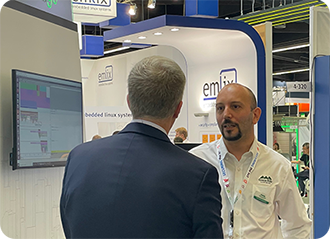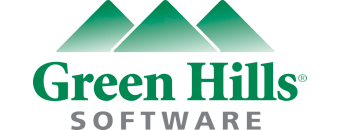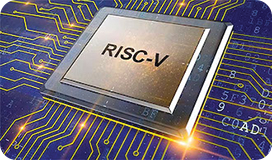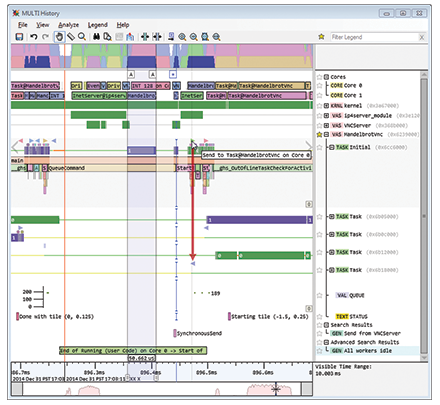Green Hills Software's embedded software technology thought-leaders will present technical sessions in the Exhibitor Forum, embedded world Conference and demonstrate optimized solutions on our stand (Hall 4, Stand 325). See compelling solution demonstrations that tackle real-world challenges. Experience the power of proven products and expertise with the support from our customers and partner ecosystem.
Click the button on the right below to register for the show and receive your free-of-charge exhibition ticket in advance (instead of €25.00).

- RTOS & Hypervisors for Microprocessors & Microcontrollers
- Mixed-Criticality Consolidation
- Safe and Secure Virtualization
- Signal-to-Service Translation
- e-Sync OTA Updates and AWS Cloud
- Radar Detection
- Computer Vision
- High Performance Graphical Interfaces
- AUTOSAR (Classic and Adaptive)
- Virtualized Android
- Advanced Software Tools, Cloud-Based Development and Testing
- Secure Credential Management, Security Appliances, Supply Chain Security, Device Lifecycle Management
Brought to you in cooperation with our partners at Arm, Altia, Excelfore, Google Android, Tata Elxsi, and others. Running on the newest processors from Infineon, NXP, Qualcomm, Renesas, ST and TI.
Green Hills Software is participating in embedded world's Hall 3 Exhibitor Forum, offering three sessions open to all attendees on the show floor in Hall 3, Stand 561.
The number of safety-critical software functions in automotive, medical, industrial, railway and infrastructure applications is rapidly increasing. The software architectures that implement these vary widely – from a simple and robust e-fuse to a cloud-connected mission-critical device. The commonality between these safety functions is the need to fulfill industry safety standards requirements.
This session begins by focusing on a simple function and discusses an approach to address its requirements using a lean open platform that enables modular application development. The session will then discuss how this platform fits into an industry trend that aims to establish a homogeneous application development platform applicable to the full spectrum of safe software functions.
Chip designs continue to get more complex – enabling feature rich products with optimized computing capability. System-on-Chip solutions are integrating multicore designs with special purpose cores – creating very capable heterogeneous designs. But this complexity is also complicating development and debug of such systems as the processing load is distributed across multiple cores, potentially running different operating systems, and utilizing different debug methods. This brings about the need for more integration of the software development and debug capabilities into a TRULY INTEGRATED Development Environment.
We will discuss code generation options, system level debugging from bare metal bootup to applications running on a High-Level Operating System, and visibility into finer details such as detailed time tracing of tasks and inter-processor communications, while increasing productivity of diversified development teams through leveraging the last AGILE development methodologies.
Functional Safety is a complex topic. Functionally safe systems are even more complex, as they are comprised of hardware, software, and various other elements that make up the complete system. Studies have show that starting with certified functional safety elements to create such systems saves several man-years of effort and expense, and leads to faster time-to-market.
This presentation will discuss the requirements to create functional safety systems, and how to leverage the expertise of both hardware and software foundations – thus allowing the manufacturer to focus on integration of the rest of the system and the tools available to aid in that process.
With RISC-V's growing adoption and increased use in time-critical, safety-certified production programs, selecting the right software solutions is essential for successful program deployment. Green Hills Software's mature and proven safety-certified embedded software solutions for RISC-V enable the efficient development and cost-effective deployment of RISC-V-based designs in systems that require functional safety and security.
In this session we will introduce Green Hills Software's RISC-V offerings that feature certified real-time operating systems, C/C++ compilers and intuitive multicore debugging, drawing upon the company's 40-years of successful customer program deployment experience.
Serge Plagnol and Dr. Carmelo Loiacono of Green Hills Software will present a full day of classes covering the following topics:
- Modern C++ for Embedded Development
- Challenges in multithreading/multicore applications
- Advanced Debugging Techniques (Live Demo)
Faulty design in complex embedded systems (such as virtualized systems) can sometimes cause performance issues. In this scenario, analyzing the causes leading to performance degradation is difficult because they can be impossible to identify. Designs that properly address functional and performance requirements can reduce and even eliminate the risk of an underperforming virtualized embedded system going into production.
As the trend of consolidating completely different software functionalities, especially the introduction of Zonal Architectures in automotive, gains momentum, it exponentially increases both system complexity and the difficulty of analyzing performance parameters. As a result, advanced performance analysis tools combined with proper design are now essential to ensure that real-time applications and guest operating systems execute within overall system requirements.
In this session, we show modern techniques for analysis and design of virtualized systems on Multicore processors. We will examine different SoC types that provide virtualization capabilities by analyzing the software components, critical for performance and real-time, of both the hypervisor and Guest OS systems. Finally, we will focus on use cases proving the effectiveness of the design and analysis techniques examined.
It is commonly considered that the use of partitioning to run applications in separate environments results in better embedded security. This partitioning is typically achieved using hypervisors, although memory separation is the idea behind regular application processes inside an operating system as well.
It can be misleading to assume hypervisors are the only solution for secure separation. There are other less-known techniques, such as using separation kernels. Hypervisors introduce another software layer that may have additional risks and potential vulnerabilities which can effect system safety and security. This completely undermines the goals of adding virtualization to improve safety and security in the first place.
With separation kernels, it is possible to mitigate safety and security risks and build a different type of software architecture that addresses security problems without the overhead of a hypervisor. This session will introduce the problem domain and talk in-depth about how a foundational software separation architecture address some of these challenges.
"Our system has an issue, we urgently need to get a trace of the error!" says the project manager in a meeting with the developers. Does this sound familiar? Usually this kind of error could be, for example, a system crash, a wrong calculation or a missed deadline. Or maybe the program is just too slow. And what exactly he means by "trace" is not always clear in such a case. In some companies we are talking about thousands and thousands of printf() outputs on the serial console, in some other we talk about hardware trace and sometimes it is an analysis using code instrumentation and a suitable software tool.
All of these different approaches have their pros and cons, such as the cost of acquiring the tools, their runtime overhead, or memory overhead.
This talk discusses different methods of tracing program flow and compares their overhead. The audience will understand important differences in trace techniques to make the right decisions in the testing and analysis strategy of software projects. It might help to get away from old, inefficient methods of software troubleshooting and towards modern methodologies.
The methods and measurement results presented are based on our own studies and experience in supporting complex customer projects.














